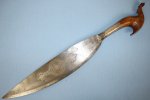- Joined
- Mar 6, 2015
- Messages
- 88
Is there a standard thickness for this model . Are they thinner than say an Angkola ?
The BladeForums.com 2024 Traditional Knife is available! Price is $250 ea (shipped within CONUS).
Order here: https://www.bladeforums.com/help/2024-traditional/



I'm no expert neither but I agree. Pretty sure it's tourist.From the inscriptions and grind and general quality to me I think it is a tourist model that might have been bought in the seventies but doesnt look like a military issue compared to what i have seen. Just my opinion tho im no expert so dont take that to the bank. No more markings?
I have several WWII era khukuris of different models, and the corresponding modern versions by HI. Without exception the vintage blades are thinner and lighter weight, but still very strong. That makes sense, since they were military issue and intended as both weapon and tool, whereas the new versions are unlikely to ever be used in combat. Even the Gurkhas nowadays are more likely to use assault rifles and helicopters.
Here's one comparison. A vintage 18" M43 returned by a U.S. serviceman from the WWII Pacific Theater that weighs about 24 oz, and a modern HI 18.5" M43 by Kumar that weighs about 36 oz.
Of course the modern HI khukuris vary a lot in weight, since they are handmade, but the above comparison is somewhat typical. My vintage M43 is marked "QEYOOM BROS, 1944." I read somewhere that Qeyoom Bros was an Indian company that made khukuris for the British during WWII, and that they were in a part of India that became Pakistan after the partition.
View attachment 1945564View attachment 1945565



A fighting blade can get its strength from width rather than thickness. The Moro Barong, for example, is a wide blade, not very thick, but these weapons in the hands of an expert warrior were famous for cleaving British soldiers in half, back in the day. Expertise is the key. If the blade is swept in a perfectly parallel swing it will cut very deeply. If it is swung at an angle, the width can drag or even turn the blade.
My own Moro Barong is put away, but here's a picture of another almost identical one (mine doesn't have the engraving on the blade). Specs: Spine thickness is 1/4" at the handle, tapering down toward the edge and the point. Blade width at the belly is 3", overall length is 20.5," blade length is 14.5", weight is only 22 oz. The handle is carved from a beautiful piece of hardwood burl, extremely comfortable in the hand. This is fairly small for a Barong. I chose a smaller one because it takes up less space, but it is an imposing blade.
View attachment 1947612
